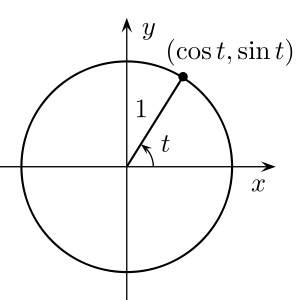Arrow–Debreu model
In mathematical economics, the Arrow–Debreu model suggests that under certain economic assumptions (convex preferences, perfect competition, and demand independence) there must be a set of prices such that aggregate supplies will equal aggregate demands for every commodity in the economy.[1]
The model is central to the theory of general (economic) equilibrium and it is often used as a general reference for other microeconomic models. It is named after Kenneth Arrow, Gérard Debreu,[2] and sometimes also Lionel W. McKenzie for his independent proof of equilibrium existence in 1954[3] as well as his later improvements in 1959.[4][5]
The A-D model is one of the most general models of competitive economy and is a crucial part of general equilibrium theory, as it can be used to prove the existence of general equilibrium (or Walrasian equilibrium) of an economy. In general, there may be many equilibria; however, with extra assumptions on consumer preferences, namely that their utility functions be strongly concave and twice continuously differentiable, a unique equilibrium exists. With weaker conditions, uniqueness can fail, according to the Sonnenschein–Mantel–Debreu theorem.
Convex sets and fixed points

In 1954, McKenzie and the pair Arrow and Debreu independently proved the existence of general equilibria by invoking the Kakutani fixed-point theorem on the fixed points of a continuous function from a compact, convex set into itself. In the Arrow–Debreu approach, convexity is essential, because such fixed-point theorems are inapplicable to non-convex sets. For example, the rotation of the unit circle by 90 degrees lacks fixed points, although this rotation is a continuous transformation of a compact set into itself; although compact, the unit circle is non-convex. In contrast, the same rotation applied to the convex hull of the unit circle leaves the point (0,0) fixed. Notice that the Kakutani theorem does not assert that there exists exactly one fixed point. Rotating the unit disk by 360 degrees leaves the entire unit disk fixed, so that this rotation has an infinite number of fixed points.
Non-convexity in large economies
The assumption of convexity precluded many applications, which were discussed in the Journal of Political Economy from 1959 to 1961 by Francis M. Bator, M. J. Farrell, Tjalling Koopmans, and Thomas J. Rothenberg.[6] Ross M. Starr (1969) proved the existence of economic equilibria when some consumer preferences need not be convex.[6] In his paper, Starr proved that a "convexified" economy has general equilibria that are closely approximated by "quasi-equilbria" of the original economy; Starr's proof used the Shapley–Folkman theorem.[7]
Economics of uncertainty: Insurance and finance
Compared to earlier models, the Arrow–Debreu model radically generalized the notion of a commodity, differentiating commodities by time and place of delivery. So, for example, "apples in New York in September" and "apples in Chicago in June" are regarded as distinct commodities. The Arrow–Debreu model applies to economies with maximally complete markets, in which there exists a market for every time period and forward prices for every commodity at all time periods and in all places.
The Arrow–Debreu model specifies the conditions of perfectly competitive markets.
In financial economics the term Arrow–Debreu is most commonly used with reference to an Arrow–Debreu security. A canonical Arrow–Debreu security is a security that pays one unit of numeraire if a particular state of the world is reached and zero otherwise (the price of such a security being a so-called "state price"). As such, any derivatives contract whose settlement value is a function on an underlying whose value is uncertain at contract date can be decomposed as linear combination of Arrow–Debreu securities.
Since the work of Breeden and Lizenberger in 1978,[8] a large number of researchers have used options to extract Arrow–Debreu prices for a variety of applications in financial economics.[9]
See also
- Model (economics)
- Incomplete markets
- Fisher market - a simpler market model, in which the total quantity of each product is given, and each buyer comes only with a monetary budget.
References
- ↑ Arrow, K. J.; Debreu, G. (1954). "Existence of an equilibrium for a competitive economy". Econometrica. 22 (3): 265–290. doi:10.2307/1907353.
- ↑ EconomyProfessor.com, Retrieved 2010-05-23
- ↑ McKenzie, Lionel W. (1954). "On Equilibrium in Graham's Model of World Trade and Other Competitive Systems". Econometrica. 22 (2): 147–161. JSTOR 1907539. doi:10.2307/1907539.
- ↑ McKenzie, Lionel W. (1959). "On the Existence of General Equilibrium for a Competitive Economy". Econometrica. 27 (1): 54–71. JSTOR 1907777. doi:10.2307/1907777.
- ↑ For an exposition of the proof, see Takayama, Akira (1985). Mathematical Economics (2nd ed.). London: Cambridge University Press. pp. 265–274. ISBN 0-521-31498-4.
- 1 2 Starr, Ross M. (1969), "Quasi–equilibria in markets with non–convex preferences (Appendix 2: The Shapley–Folkman theorem, pp. 35–37)", Econometrica, 37 (1): 25–38, JSTOR 1909201, doi:10.2307/1909201.
- ↑ Starr, Ross M. (2008). "Shapley–Folkman theorem". In Durlauf, Steven N.; Blume, Lawrence E.,. The New Palgrave Dictionary of Economics. 4 (Second ed.). Palgrave Macmillan. pp. 317–318. doi:10.1057/9780230226203.1518.
- ↑ Breeden, Douglas T.; Litzenberger, Robert H. (1978). "Prices of State-Contingent Claims Implicit in Option Prices". Journal of Business. 51 (4): 621–651. JSTOR 2352653. doi:10.1086/296025.
- ↑ Almeida, Caio; Vicente, José (2008). "Are interest rate options important for the assessment of interest risk?" (PDF). Working Papers Series n. 179, Central Bank of Brazil.
Further reading
- Athreya, Kartik B. (2013). "The Modern Macroeconomic Approach and the Arrow–Debreu–McKenzie Model". Big Ideas in Macroeconomics: A Nontechnical View. Cambridge: MIT Press. pp. 11–46. ISBN 978-0-262-01973-6.
- Geanakoplos, John (1987). "Arrow–Debreu model of general equilibrium". The New Palgrave: A Dictionary of Economics. 1. pp. 116–124.
- Takayama, Akira (1985). Mathematical Economics (2nd ed.). London: Cambridge University Press. pp. 255–284. ISBN 0-521-31498-4.
- Düppe, Till (2012). "Arrow and Debreu de-homogenized". Journal of the History of Economic Thought. 34 (4): 491–514. doi:10.1017/s1053837212000491.
External links
- Notes on the Arrow–Debreu–McKenzie Model of an Economy, Prof. Kim C. Border California Institute of Technology
- "The Fundamental Theorem" of Finance; part II. Prof. Mark Rubinstein, Haas School of Business